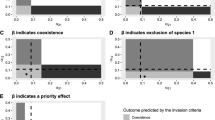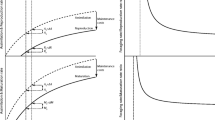Abstract
We study the evolution of an individual’s reproductive strategy in a mechanistic modeling framework. We assume that the total number of juveniles one adult individual can produce is a finite constant, and we study how this number should be distributed during the season, given the types of inter-individual interactions and mortality processes included in the model. The evolution of the timing of reproduction in this modeling framework has already been studied earlier in the case of equilibrium resident dynamics, but we generalize the situation to also fluctuating population dynamics. We find that, as in the equilibrium case, the presence or absence of inter-juvenile aggression affects the functional form of the evolutionarily stable reproductive strategy. If an ESS exists, it can have an absolutely continuous part only if inter-juvenile aggression is included in the model. If inter-juvenile aggression is not included in the model, an ESS can have no continuous parts, and only Dirac measures are possible.
Similar content being viewed by others
References
Beverton, R. J. H., & Holt, S. J. (Eds.) (1957). Fisheries investigations : Vol. 19. On the dynamics of exploited fish populations. London: H.M. Stationery Office.
Brommer, J., Kokko, H., & Pietiäinen, H. (2000). Reproductive effort and reproductive values in periodic environments. Am. Nat., 155, 454–472.
Bulmer, M. G. (1983). Models for the evolution of protandry in insects. Theor. Popul. Biol., 23, 314–322.
Dawson, P. S. (1977). Life history strategy and evolutionary history of Tribolium flour beetles. Evolution, 31, 226–229.
Eskola, H. T. M. (2009). On the evolution of the timing of reproduction. Theor. Popul. Biol., 75, 98–108.
Eskola, H. T. M., & Geritz, S. A. H. (2007). On the mechanistic derivation of various discrete-time population models. Bull. Math. Biol., 69, 329–346.
Ferrière, R., & Gatto, M. (1995). Lyapunov exponents and the mathematics of invasion in oscillatory or chaotic populations. Theor. Popul. Biol., 48, 126–171.
Gyllenberg, M., Hanski, I., & Lindström, T. (1996). A predator-prey model with optimal suppression of reproduction in the prey. Math. Biosci., 134, 119–152.
Gyllenberg, M., Hanski, I., & Lindström, T. (1997). Continuous versus discrete single species population models with adjustable reproduction strategies. Bull. Math. Biol., 59, 679–705.
Gyllenberg, M., Hanski, I., & Lindström, T. (in press). Conditional reproductive strategies under variable environmental conditions. In U. Dieckmann & J. A. J. Metz (Eds.), Elements of adaptive dynamics. Cambridge: Cambridge University Press.
Haccou, P., & Iwasa, Y. (1995). Optimal mixed strategies in stochastic environments. Theor. Popul. Biol., 47, 212–243.
Harvey, P. H., Partridge, L., & Southwood, T. R. E. (Eds.) (1991). The evolution of reproductive strategies. The Royal Society.
Hassell, M. P. (1975). Density-dependence in single-species populations. J. Anim. Ecol., 44, 283–295.
Iwasa, Y., & Haccou, P. (1994). ESS emergence pattern of male butterflies in stochastic environments. Evol. Ecol., 8, 503–523.
Iwasa, Y., Odendaal, F. J., Murphy, D. D., Ehrlich, P. R., & Launer, A. E. (1983). Emergence patterns in male butterflies: a hypothesis and a test. Theor. Popul. Biol., 23, 363–379.
Lalonde, R. G., & Roitberg, B. D. (2006). Chaotic dynamics can select for long-term dormancy. Am. Nat., 168, 127–131.
Lewontin, R. C., & Cohen, D. (1969). On population growth in a randomly varying environment. Proc. Natl. Acad. Sci. USA, 62, 1056–1060.
Maynard Smith, J., & Price, G. R. (1973). The logic of animal conflict. Nature, 246, 15–18.
Metz, J. A. J., Nisbet, R. M., & Geritz, S. A. H. (1992). How should we define “fitness” for general ecological scenarios? Trends Ecol. Evol., 7, 198–202.
Parvinen, K., Dieckmann, U., & Heino, M. (2006). Function-valued adaptive dynamics and the calculus of variations. J. Math. Biol., 52, 1–26.
Ringel, M. S., Rees, M., & Godfray, H. C. J. (1998). The evolution of diapause in a coupled host-parasitoid system. J. Theor. Biol., 194, 195–204.
Roff, D. A. (1992). Evolution of life histories: theory and analysis. New York: Chapman & Hall.
Sasaki, A., & Ellner, S. (1995). The evolutionarily stable phenotype distribution in a random environment. Evolution, 49, 337–350.
Satake, A., Sasaki, A., & Iwasa, Y. (2001). Variable timing of reproduction in unpredictable environments: adaptation of flood plain plants. Theor. Popul. Biol., 60, 1–15.
Stearns, S. C. (1992). The evolution of life histories. Oxford: Oxford University Press.
Stearns, S. C. (2000). Life history evolution: successes, limitations, and prospects. Naturwissenschaften, 87, 476–486.
Thieme, H. R. T. (2003). Mathematics in population biology. Princeton: Princeton University Press.
Van Dooren, T. J. M., & Metz, J. A. J. (1998). Delayed maturation in temporally structured populations with non-equilibrium dynamics. J. Evol. Biol., 11, 41–62.
Wan, F. Y. M. (1995). Introduction to the calculus of variations and its applications. New York: Chapman & Hall.
Yoshimura, J., & Jansen, V. A. A. (1996). Evolution and population dynamics in stochastic environments. Res. Popul. Ecol., 38, 165–182.
Author information
Authors and Affiliations
Corresponding author
Rights and permissions
About this article
Cite this article
Eskola, H.T.M., Geritz, S.A.H. & Gyllenberg, M. On the Evolution of the Timing of Reproduction with Non-equilibrium Resident Dynamics. Bull Math Biol 73, 1312–1332 (2011). https://doi.org/10.1007/s11538-010-9560-1
Received:
Accepted:
Published:
Issue Date:
DOI: https://doi.org/10.1007/s11538-010-9560-1




